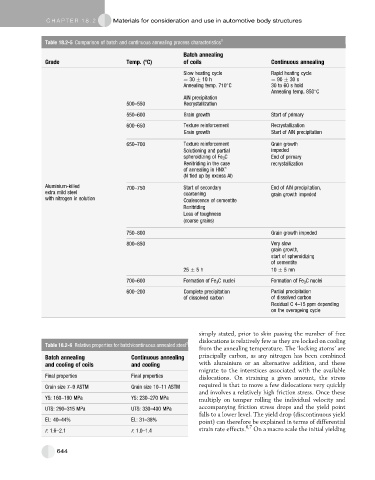Page 636 - Automotive Engineering Powertrain Chassis System and Vehicle Body
P. 636
CHAP TER 1 8. 2 Materials for consideration and use in automotive body structures
Table 18.2-5 Comparison of batch and continuous annealing process characteristics 1
Batch annealing
Grade Temp. (8C) of coils Continuous annealing
Slow heating cycle Rapid heating cycle
¼ 30 10 h ¼ 90 30 s
Annealing temp. 710 C 30 to 60 s hold
Annealing temp. 850 C
AIN precipitation
500–550 Recrystallization
550–600 Grain growth Start of primary
600–650 Texture reinforcement Recrystallization
Grain growth Start of AIN precipitation
650–700 Texture reinforcement Grain growth
Solutioning and partial impeded
spheroidizing of Fe 3 C End of primary
Renitriding in the case recrystallization
of annealing in HNX )
(N tied up by excess Al)
Aluminium-killed 700–750 Start of secondary End of AIN precipitation,
extra mild steel coarsening grain growth impeded
with nitrogen in solution Coalescence of cementite
Renitriding
Loss of toughness
(coarse grains)
750–800 Grain growth impeded
800–850 Very slow
grain growth,
start of spheroidizing
of cementite
25 5h 10 5mn
700–600 Formation of Fe 3 C nuclei Formation of Fe 3 C nuclei
600–200 Complete precipitation Partial precipitation
of dissolved carbon of dissolved carbon
Residual C 4–15 ppm depending
on the overageing cycle
simply stated, prior to skin passing the number of free
dislocations is relatively few as they are locked on cooling
Table 18.2-6 Relative properties for batch/continuous annealed steel 3
from the annealing temperature. The ‘locking atoms’ are
Batch annealing Continuous annealing principally carbon, as any nitrogen has been combined
and cooling of coils and cooling with aluminium or an alternative addition, and these
migrate to the interstices associated with the available
Final properties Final properties dislocations. On straining a given amount, the stress
Grain size 7–9 ASTM Grain size 10–11 ASTM required is that to move a few dislocations very quickly
and involves a relatively high friction stress. Once these
YS: 160–190 MPa YS: 230–270 MPa multiply on temper rolling the individual velocity and
UTS: 290–315 MPa UTS: 330–400 MPa accompanying friction stress drops and the yield point
falls to a lower level. The yield drop (discontinuous yield
El.: 40–44% El.: 31–38% point) can therefore be explained in terms of differential
r: 1.6–2.1 r: 1.0–1.4 strain rate effects. 6,7 On a macro scale the initial yielding
644

